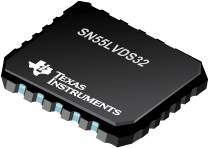

SN55LVDS32是TI公司的一款LVDSPHY(<800Mbps)产品,SN55LVDS32是四路 LVDS 接收器,本页介绍了SN55LVDS32的产品说明、应用、特性等,并给出了与SN55LVDS32相关的TI元器件型号供参考。
SN55LVDS32 - 四路 LVDS 接收器 - LVDSPHY(<800Mbps) - LVDS/M-LVDS/ECL/CML - TI公司(Texas Instruments,德州仪器)
The SN55LVDS32, SN65LVDS32, SN65LVDS3486, and SN65LVDS9637 devices are differential line receivers that implement the electrical characteristics of low-voltage differential signaling (LVDS). This signaling technique lowers the output voltage levels of 5-V differential standard levels (such as EIA/TIA-422B) to reduce the power, increase the switching speeds, and allow operation with a 3.3-V supply rail. Any of the differential receivers provides a valid logical output state with a ±100-mV differential input voltage within the input common-mode voltage range. The input common-mode voltage range allows 1 V of ground potential difference between two LVDS nodes.
The intended application of these devices and signaling technique is both point-to-point and multidrop (one driver and multiple receivers) data transmission over controlled impedance media of approximately 100 Ω. The transmission media may be printed-circuit board traces, backplanes, or cables. The ultimate rate and distance of data transfer depends on the attenuation characteristics of the media and the noise coupling to the environment.
The SN65LVDS32, SN65LVDS3486, and SN65LVDS9637 devices are characterized for operation from –40°C to 85°C. The SN55LVDS32 device is characterized for operation from –55°C to 125°C.
- Meet or Exceed the Requirements of ANSI TIA/EIA-644 Standard
- Operate With a Single 3.3-V Supply
- Designed for Signaling Rates of up to 150 Mbps
- Differential Input Thresholds ±100 mV Max
- Typical Propagation Delay Time of 2.1 ns
- Power Dissipation 60 mW Typical Per Receiver at Maximum Data Rate
- Bus-Terminal ESD Protection Exceeds 8 kV
- Low-Voltage TTL (LVTTL) Logic Output Levels
- Pin Compatible With AM26LS32, MC3486, and µA9637
- Open-Circuit Fail-Safe
- Cold Sparing for Space and High-Reliability Applications Requiring Redundancy







